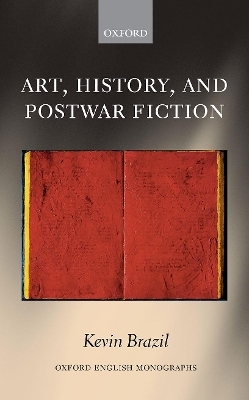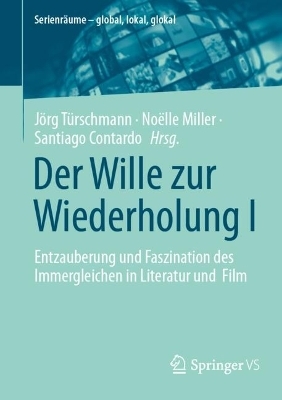
Art, History, and Postwar Fiction
Seiten
2018
Oxford University Press (Verlag)
978-0-19-882445-9 (ISBN)
Oxford University Press (Verlag)
978-0-19-882445-9 (ISBN)
Art, History, and Postwar Fiction explores the ways in which twenty-century novelists responded to visual art and how writing about art was often a means of commenting on historical developments of the period.
Art, History, and Postwar Fiction explores the ways in which novelists responded to the visual arts from the aftermath of the Second World War to the present day. If art had long served as a foil to enable novelists to reflect on their craft, this book argues that in the postwar period, novelists turned to the visual arts to develop new ways of conceptualizing the relationship between literature and history. The sense that the novel was becalmed in the end of history was pervasive in the postwar decades. In seeming to bring modernism to a climax whilst repeating its foundational gestures, visual art also raised questions about the relationship between continuity and change in the development of art.
In chapters on Samuel Beckett, William Gaddis, John Berger, and W. G. Sebald, and shorter discussions of writers like Doris Lessing, Kathy Acker, and Teju Cole, this book shows that writing about art was often a means of commenting on historical developments of the period: the Cold War, the New Left, the legacy of the Holocaust. Furthermore, it argues that forms of postwar visual art, from abstraction to the readymade, offered novelists ways of thinking about the relationship between form and history that went beyond models of reflection or determination. By doing so, this book also argues that attention to interactions between literature and art can provide critics with new ways to think about the relationship between literature and history beyond reductive oppositions between formalism and historicism, autonomy and context.
Art, History, and Postwar Fiction explores the ways in which novelists responded to the visual arts from the aftermath of the Second World War to the present day. If art had long served as a foil to enable novelists to reflect on their craft, this book argues that in the postwar period, novelists turned to the visual arts to develop new ways of conceptualizing the relationship between literature and history. The sense that the novel was becalmed in the end of history was pervasive in the postwar decades. In seeming to bring modernism to a climax whilst repeating its foundational gestures, visual art also raised questions about the relationship between continuity and change in the development of art.
In chapters on Samuel Beckett, William Gaddis, John Berger, and W. G. Sebald, and shorter discussions of writers like Doris Lessing, Kathy Acker, and Teju Cole, this book shows that writing about art was often a means of commenting on historical developments of the period: the Cold War, the New Left, the legacy of the Holocaust. Furthermore, it argues that forms of postwar visual art, from abstraction to the readymade, offered novelists ways of thinking about the relationship between form and history that went beyond models of reflection or determination. By doing so, this book also argues that attention to interactions between literature and art can provide critics with new ways to think about the relationship between literature and history beyond reductive oppositions between formalism and historicism, autonomy and context.
Kevin Brazil is a Lecturer in Twentieth and Twenty-First Century Literature at the University of Southampton. He is co-editor of Doris Lessing and the Forming of History (2016) and has published widely on twentieth- and twenty-first century fiction, in Modernism/modernity, Textual Practice, and the Journal for Modern Literature.
Introduction: Reviewing Postwar Fiction
1: Pig Vomit: Beckett's Art Historical Necessities
2: Canvas in the Cold War: William Gaddis and the Context of Art
3: The Moment of History: John Berger's Modernism after Realism
4: Art's Swindle: W. G. Sebald and History After Trauma
Conclusion: The Perspective of the Present
| Erscheinungsdatum | 08.01.2019 |
|---|---|
| Reihe/Serie | Oxford English Monographs |
| Zusatzinfo | 3 halftones |
| Verlagsort | Oxford |
| Sprache | englisch |
| Maße | 144 x 224 mm |
| Gewicht | 380 g |
| Themenwelt | Kunst / Musik / Theater ► Kunstgeschichte / Kunststile |
| Geisteswissenschaften ► Sprach- / Literaturwissenschaft ► Anglistik / Amerikanistik | |
| Geisteswissenschaften ► Sprach- / Literaturwissenschaft ► Literaturwissenschaft | |
| ISBN-10 | 0-19-882445-9 / 0198824459 |
| ISBN-13 | 978-0-19-882445-9 / 9780198824459 |
| Zustand | Neuware |
| Haben Sie eine Frage zum Produkt? |
Mehr entdecken
aus dem Bereich
aus dem Bereich
Poetik eines sozialen Urteils
Buch | Hardcover (2023)
De Gruyter (Verlag)
CHF 83,90
Entzauberung und Faszination des Immergleichen in Literatur und Film
Buch | Softcover (2024)
Springer Fachmedien Wiesbaden GmbH (Verlag)
CHF 118,95
Buch | Softcover (2024)
belleville (Verlag)
CHF 27,95


